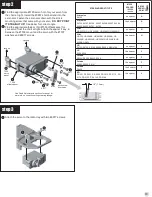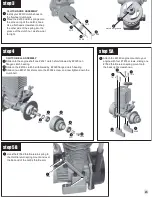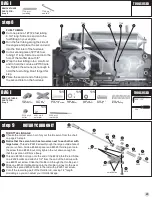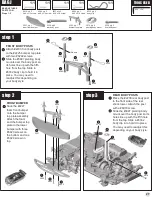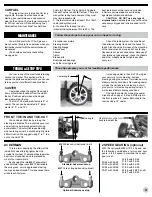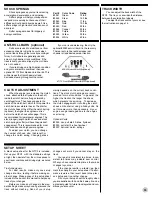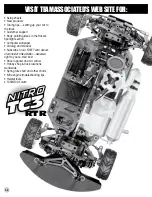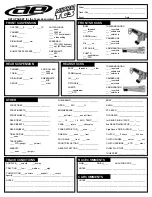
ANTI-ROLL BARS (optional)
Roll bars are used to stabilize a car from
excessive chassis roll (which occurs when
your car leans through the turns by centrifugal
force). Anti-roll bars are generally used on
smooth, high traction track conditions. If the
track is bumpy and are slippery, then roll bars
are not needed.
If youre driving on a high traction condition
and your car wants to oversteer, then use
optional #1715 front blade anti-roll bar kit. This
will decrease the front chassis roll and
decrease steering throughout the corner.
CLUTCH ADJUSTMENT
When the engine revs increase, the clutch
shoes, attached to the flywheel on the shaft
inside the clutch bell, are flung outward by
centrifugal force. The shoes engage to the
inside of the clutch bell, which in turn power the
clutch bell to accelerate the car. The shorter
the clutch shoes or the stiffer the clutch spring
(optional), the higher the engine must rev
before the clutch shoes will engage. This is
recommended for lower power engines. The
stock (longer) length clutch shoes and stock
clutch springs (softer) will have the quickest
engagement. This is recommended for most
track conditions and high power engines.
To adjust your clutch, you can change
the number of shoes, alter their length or
change the clutch spring. Changing shoes
mainly depends on the current track condi-
tions. The stock clutch springs are recom-
mended for most conditions. In general, the
higher the traction the longer the shoes,
which prevents tire spinning. To decrease
the clutch engagement, try cutting the clutch
shoes a little shorter using a hobby knife. Do
not trim away more than necessary, or your
engine can get damaged due to the engine
over-reving.
Optional Parts:
#2324, non pull start 3-shoe flywheel
#2325, pull start 3-shoe flywheel
#2307, optional clutch springs
If your car is understeering, then try the
optional #3960 anti-roll bar kit in the rear only.
The rear antiroll bar will decrease rear
chassis roll and decrease rear traction.
33
#3960 Anti-roll Bar Kit (optional)
SHOCK SPRINGS
Shock springs keep your car level during
acceleration, deceleration, and cornering.
Stiffer springs will help your suspension
respond more quickly, but because of their
stiffness will not absorb bumps as well. Use
stiffer springs in high traction conditions such
as carpet.
Softer springs are best for slippery or
bumpy conditions.
Part # Color Code
Rating
#3941
Green
12 lbs.
#3942
Sliver
14.5 lbs.
#3943
Blue
17 lbs.
#3944
Gold
19.5 lbs.
#3945
Red
22 lbs.
#3946
Copper
25 lbs.
#3952
Purple
30 lbs.
#3953
Yellow
35 lbs.
#3954
White
40 lbs.
TRACK WIDTH
You can adjust the track width of the
NTC3. That is, you can widen the distance
between the outside front wheels.
To adjust the track width of your car, see
the instructions on page 14.
SETUP SHEET
A blank setup sheet for the NTC3 is included.
Set up your NTC3 with the standard settings
at right, then deviate from them in response to
your track conditions and driving style, as noted
below.
Tips for beginners:
For best results, make only one setup
change at a time, testing it before making an-
other change. Make a copy of the setup sheet
included in the back of this manual to help keep
track of your changes.
Before you make any changes to the stan-
dard settings, make sure you can get around the
track without crashing. None of your setup
changes will work if you cannot stay on the
track.
Your goal is consistent lap times. Incon-
sistent lap times may indicate poor control.
When you have consistent lap times, then make
changes to your car.
If the change results in a faster lap, then
mark the change in your setup sheet. If perfor-
mance is worse, then revert back to the previ-
ous setup and try another change.
Fill out your setup sheet thoroughly when
you are satisfied with it and file it away. It can be
a practical guide for future track layouts and con-
ditions you encounter.
#1715 Front Blade Anti-roll Bar Kit (optional)

